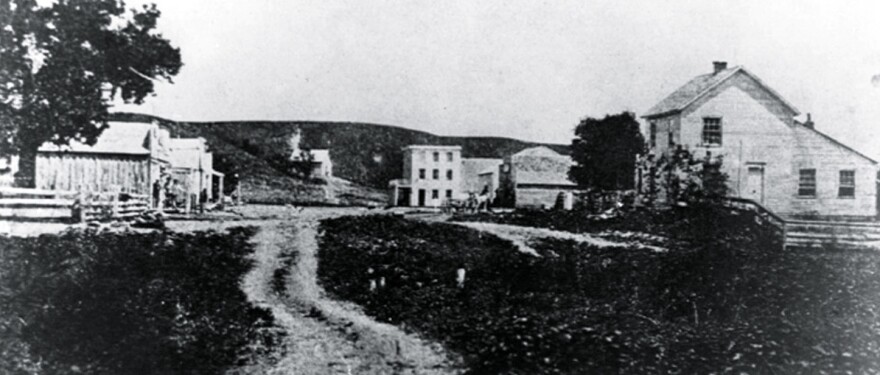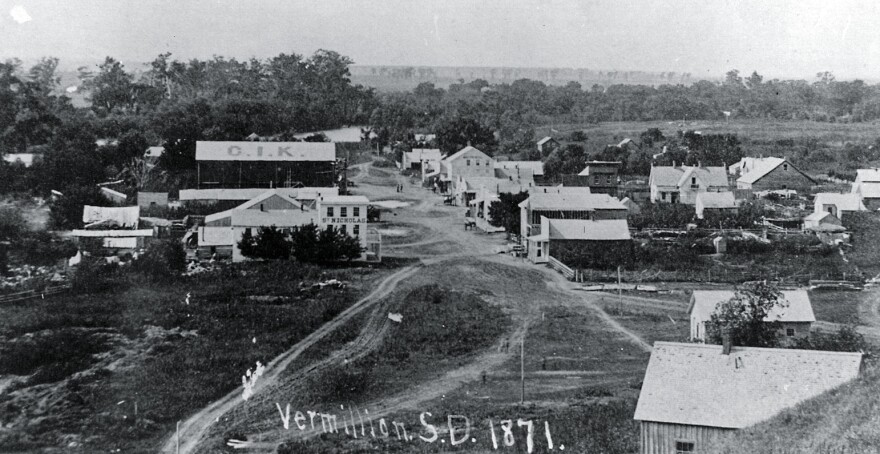Vermillion, South Dakota, was among the first towns formed in Dakota Territory after the area was opened to settlement in 1859. By 1880, it was a bustling hub of commerce and a hotbed of Territorial politics. The town was situated near the Missouri River, perhaps an ideal location for a community almost wholly dependent on steamboat transportation. There were hotels, various kinds of stores, banks, and dozens of residences.
The winter of 1880 brought an epic amount of snow to the Missouri River basin and when the spring thaw arrived in 1881, the river ice began to break up and pile up into enormous ice jams. The jams held back the spring meltwater with disastrous effect. Yankton, up stream from Vermillion, was flooded first, badly damaged but not beyond repair. Vermillion, on the other hand, was all but wiped out. Community residents chose to rebuild their town on higher ground.
Listen to an interview with retired judge and current State Senator Art Rusch on SDPB's "In the Moment" midday radio program, Monday, April 25, 2022. Rusch is a member of the Clay County Historical Society and wrote an article entitled "Vermillion Before the Flood," for the South Dakota State Historical Society's "South Dakota History" magazine. (Or read the interview transcript below.)



Lori Walsh: As one of the first towns in Dakota territory, Vermillion had a prominent role in the early territorial settlement of the Missouri River basin. But it all came to an end in the spring of 1881. For today's images in the past, we're going to take a look at how a natural disaster wiped out the town and forced residents to choose between abandoning what was left or rebuilding it from scratch. Joining me for the conversation is Art Rusch, he's a retired judge, a state Senator, and author of an article, Vermillion Before the Flood, that was published a few years back in the South Dakota State Historical Society Journal. Judge Rusch, welcome, thanks for being here.
Art Rusch: Well, thank you.
Lori Walsh: This town of Vermillion that we know today originally was in an entirely different location. Take us back to 1859 or so, when people had been working so hard to build a community and what happened next?
Art Rusch: Well, Vermillion was quite different because the Missouri River at that time, ran along the north side of the valley, here. And the original town of Vermillion was built along the Missouri River, was a Steamboat stop, there along the river. And it was below the bluff. There's still houses there. There's still buildings there, but the entire town was originally below the bluff.
Lori Walsh: How thriving was it at that point? What were some of the sort of milestones that we could see happening in that town?
Art Rusch: Well, originally Vermillion was the biggest town in the territory. It was actually the residents of Vermillion thought that they would be named the capital rather than Yankton, when Dakota Territory was found. And when President Lincoln named his family doctor from Springfield as the territorial governor and he came overland from Sioux City, Vermillion thought that they had a real chance of getting him to stop here and persuade him to Vermillion as the capital. It didn't happen probably because of Mary Todd Lincoln's cousin, JBS Todd, who had been one of the land owners for the Yankton town site. And the speculation always has been that Dr. Jayne had his orders from Mary Todd Lincoln, to pick her cousin's town site rather than Vermillion.
Lori Walsh: All right. So this is Yankton Indian land. It's also thriving fur trade area. It's not the first time really commerce has been successful in this part of the world.
Art Rusch: Well, that's right. Lewis and Clark had stopped here and there'd been fur traders up and down the river for quite a few years already. Fort Pierre up river had been established, Fort Randall had been established. But this was still part of the Indian land and the settlers were not allowed here until the 1858 Treaty with the Yankton Sioux.
Lori Walsh: All right. Let's jump ahead a little bit and talk about the flood and what exactly happened during that natural disaster.
Art Rusch: Okay. Well, everybody, all of your listeners are probably familiar with the long winter, Laura Ingles Wilder's book about the long winter. And that was probably one of the most significantly difficult winters in this upper Midwest. She was quite a few miles north of the Vermillion area, but this whole area was covered with snow and it's snowed and snowed and snowed. And in the spring, when that snow all melted, it all came down the river.
Lori Walsh: When did people start realizing that it was a crisis?
Art Rusch: Well, it wasn't just Vermillion, Yankton of course, was badly damaged too, in that flood. But it was actually, in late March and early April that this happened.
Lori Walsh: What was destroyed, what was lost?
Art Rusch: Well, essentially the entire downtown, the entire town below the bluff. At that point, there were a couple of houses that had been built up on the bluff, but most of the town was below the bluff and the entire, what's Broadway Street today, was the downtown district. And that was badly damaged. There were a couple of brick buildings that weren't damaged too badly, but a lot of the buildings were washed away and flooded and washed down the river. The decision was made. Afterwards, there was a community meeting to make a decision about whether to rebuild the town down along Broadway Street, where it had been before, or whether to build up on the bluff and the decision was made to build it up on the bluff.
Lori Walsh: So I'm looking through this article that you wrote for South Dakota History Magazine. I'm just really curious from you personally, as you dig through this information. What was it like to uncover some of these things? Where did you look, how did you find some of these stories?
Art Rusch: Well, I've been kind of a fan of Vermillion history ever since I've lived here. And so I had been familiar with many of these stories. Some of them I'd read from the history books, some of them, I'd talk to some of the old settlers here who had not been here at the time of the flood, but who had heard the stories and I'd read a lot of the old newspaper articles.
Lori Walsh: What surprised you? Was there a moment where you thought that's particularly the human drama is unfolding in that moment?
Art Rusch: Well, particularly knowing the streets and knowing where those buildings had been, and also of course, knowing now that the river is changed channels and is on the far side of the valley now. And that actually ended up during the years that I was a judge. One of several lawsuits that I saw dealt with exactly where the South Dakota, North Dakota boundary is, and that was affected by the change of the river, and the later settlement negotiated between South Dakota and Nebraska, had changed the boundary. But there's a lot of lawsuits, that depends on exactly whether the issue took place in South Dakota or whether it took place in Nebraska.
Lori Walsh: That most likely was an interesting story to unfold. If you'd like to see some photos of how Vermillion looked after the flood, and you can find this interview and a transcript of it this afternoon, we've been talking with Art Rusch, he is a retired judge, lawmaker and wrote an article for South Dakota History Journal about the flood of Vermillion, go to our website sdpb.org/imagesofthepast. Judge Rusch, thank you, it's been a pleasure.
Art Rusch: Thank you.







